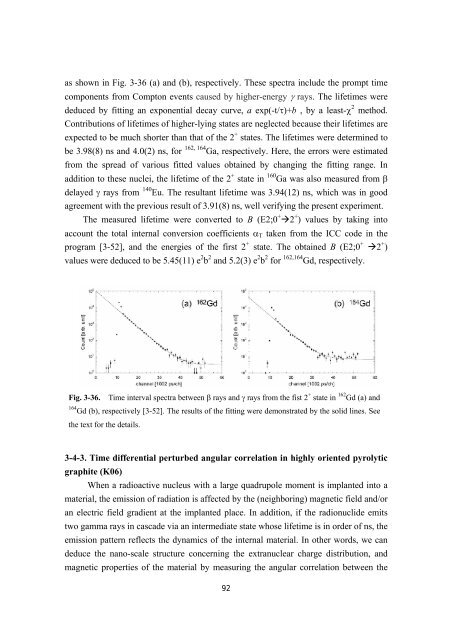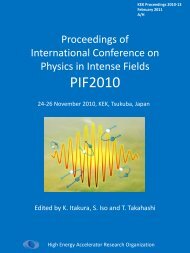TRIAC Progress Report - KEK
TRIAC Progress Report - KEK
TRIAC Progress Report - KEK
You also want an ePaper? Increase the reach of your titles
YUMPU automatically turns print PDFs into web optimized ePapers that Google loves.
as shown in Fig. 3-36 (a) and (b), respectively. These spectra include the prompt time<br />
components from Compton events caused by higher-energy γ rays. The lifetimes were<br />
deduced by fitting an exponential decay curve, a exp(-t/τ)+b , by a least-χ 2 method.<br />
Contributions of lifetimes of higher-lying states are neglected because their lifetimes are<br />
expected to be much shorter than that of the 2 + states. The lifetimes were determined to<br />
be 3.98(8) ns and 4.0(2) ns, for 162, 164 Ga, respectively. Here, the errors were estimated<br />
from the spread of various fitted values obtained by changing the fitting range. In<br />
addition to these nuclei, the lifetime of the 2 + state in 160 Ga was also measured from β<br />
delayed γ rays from 140 Eu. The resultant lifetime was 3.94(12) ns, which was in good<br />
agreement with the previous result of 3.91(8) ns, well verifying the present experiment.<br />
The measured lifetime were converted to B (E2;0 + 2 + ) values by taking into<br />
account the total internal conversion coefficients αT taken from the ICC code in the<br />
program [3-52], and the energies of the first 2 + state. The obtained B (E2;0 + 2 + )<br />
values were deduced to be 5.45(11) e 2 b 2 and 5.2(3) e 2 b 2 for 162,164 Gd, respectively.<br />
Fig. 3-36. Time interval spectra between β rays and γ rays from the fist 2 + state in 162 Gd (a) and<br />
164 Gd (b), respectively [3-52]. The results of the fitting were demonstrated by the solid lines. See<br />
the text for the details.<br />
3-4-3. Time differential perturbed angular correlation in highly oriented pyrolytic<br />
graphite (K06)<br />
When a radioactive nucleus with a large quadrupole moment is implanted into a<br />
material, the emission of radiation is affected by the (neighboring) magnetic field and/or<br />
an electric field gradient at the implanted place. In addition, if the radionuclide emits<br />
two gamma rays in cascade via an intermediate state whose lifetime is in order of ns, the<br />
emission pattern reflects the dynamics of the internal material. In other words, we can<br />
deduce the nano-scale structure concerning the extranuclear charge distribution, and<br />
magnetic properties of the material by measuring the angular correlation between the<br />
92













